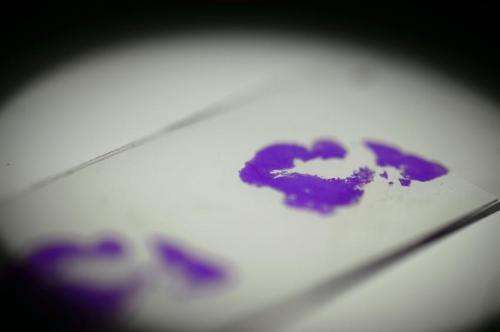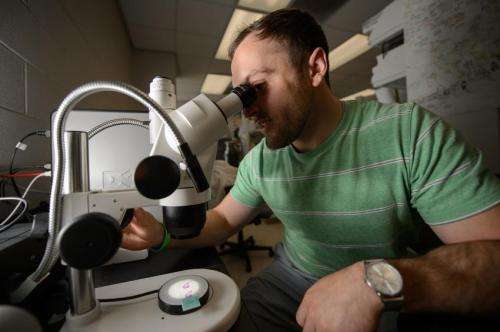A mouse tumor related to breast cancer is viewed under a microscope. Credit: G.L. Kohuth
Scientists have routinely used mice to replicate aspects of human breast cancer in an effort to find a cure to the most common type of cancer among women.
But how effective are these preclinical models in actually mimicking the disease and giving scientists the ability to develop real comparisons?
Eran Andrechek, a physiology professor in the College of Human Medicine at Michigan State University, has discovered that many of the various models used in breast cancer research can replicate several characteristics of the human disease, especially at the gene level.
The study now can be found in the journal Breast Cancer Research.
Using all the existing data that was available, Andrechek, along with MSU doctoral student Daniel Hollern, analyzed 1,172 mouse mammary tumor samples from 26 different preclinical models and was able to compile one of the largest databases to show which strains of mice were best suited to study a particular type of human breast cancer.
"We found that the vast majority of human breast cancers can be represented by one of the strains we studied," Andrechek said. "But these models have to be chosen very carefully."
Daniel Hollern is an MSU doctoral student who co-authored a study that analyzed the relationship between mice and human breast cancer. Credit: G.L. Kohuth
Careful consideration is important because not all models can replicate the same diversities found in breast cancer. One strain may show likenesses in the appearance of tumors, while others may have similarities in genes that are turned on. Yet none of the models may be effective in demonstrating the way the cancer signals to other cells that tell the disease to grow.
The research highlights the ways these models should be used to study the disease and Andrechek's new database could prove to be a valuable resource to researchers around the world.
"There are definitely clear parallels between mice and men in relation to breast cancer and this study provides legitimacy to using these models so ultimately a cure can be found," he said.
Journal information: Breast Cancer Research
Provided by Michigan State University





















